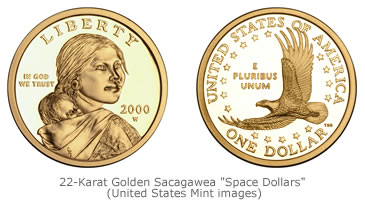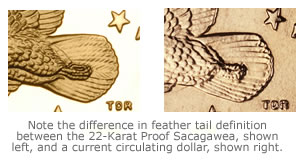Eileen Collins (Colonel, USAF, RET.) had an exceptional career with NASA. Her achievements helped springboard not  only the launch of missions, but that of the Sacagawea Dollar coins. Let’s swing through a quick series of historical events tying Collins and the Sacagawea coins together. Warp back to July 23, 1999…
only the launch of missions, but that of the Sacagawea Dollar coins. Let’s swing through a quick series of historical events tying Collins and the Sacagawea coins together. Warp back to July 23, 1999…
On that day, NASA Mission STS-93 Columbia blasted off into space carrying Chandra X-ray Observatory – one of NASA’s four Great Observatories, like the Hubble Telescope. Cool stuff!
But throw out the scientific values of the trip and two things stand out: Collins was the first woman to command a space shuttle and with her went some unique “pocket change”. The change? You guessed it… Sacagawea Golden Dollars. But these aren’t the golden dollars we’re used to seeing dispensed from post office vending machines!
To commemorate Collins’ achievement and to promote the brand new circulating Sacagawea dollars set for release in 2000, the United States Mint struck special Sacagawea Dollars. U.S Mint Director Philip N. Diehl said at the time:
"There will be two women pioneers on this flight. Commander Collins is carrying on the tradition of women trail blazers and we can’t imagine a better way to honor Sacagawea’s legacy."
Okay, so what was special about these coins you ask? The U.S. Mint actually made 39 of them. And unlike the circulating variety made of manganese brass, these were made from 22-karat .9167 fine gold! And they were proofs! Yes, real gold proofs struck on the same planchets as the half-ounce gold American Eagles. Nice. Very nice indeed. I’ll take one of those…
Although it was 1999, the coins were dated 2000 and carried the "W" Mintmark, indicating they were struck at the West Point Mint. I understand the reasoning, but pressing a date to a coin and showing it almost six months prior to the series release gives me a slightly less cozy feeling. But hey, I’d still take one… And it’s not like the mint had Congressional direction to create the coins in the first place. But that’s another story.
 Interestingly also, the reverse of each coin bears an original tail feather design that was replaced later in the year for one favoring a less prominent tail. I drummed up two included pictures where you can see the differences.
Interestingly also, the reverse of each coin bears an original tail feather design that was replaced later in the year for one favoring a less prominent tail. I drummed up two included pictures where you can see the differences.
So back to the story already… After thorough inspection, the best 12 minted coins were selected. The remaining 27 were quickly melted. The lucky 12 Sacagawea coins soared through 3Gs of gravity and into space with Collins and crew. According to NASA records, the mission lasted 118 hours and 50 minutes. Nice ride!
But seriously, these were historical and appropriate moments in time even when you consider the Sacagawea Dollar’s lackluster public acceptance.
What happened to the 22-karat Sacagawea Dollars after the mission? The expectations were that they’d get placed into museums and displayed in exhibits. That never happened. Reports indicated two of the coins did make a presence at events that year. One during a private congressional dinner (I’m not sure I’d want that one…) and one during the official Sacagawea first-strike ceremonies at the Philadelphia Mint in November.
Sadly, all 12 coins eventually made their way to Fort Knox for storage; never to be seen by the public. But, good news! Not for much longer… The 22-karat, proof Sacagawea Dollars are seeing the light of day once again.The United States Mint will display the coins at the American Numismatic Association’s World’s Fair of Money® in Milwaukee, the largest coin show in the nation. They will be showcased on August 10 at the U.S. Mint booth # 1210.






[…] 12 uniquely made 22-karat gold Sacagawea’s coins into space was certainly an interesting promotional adventure. The special proof coins were sent up on Space […]